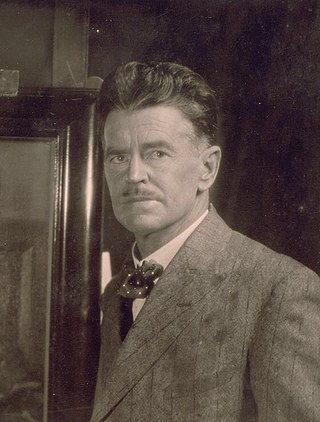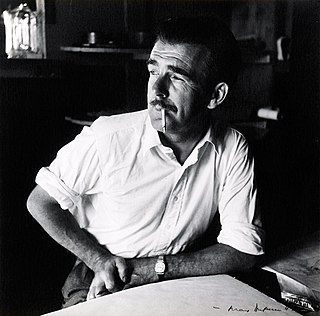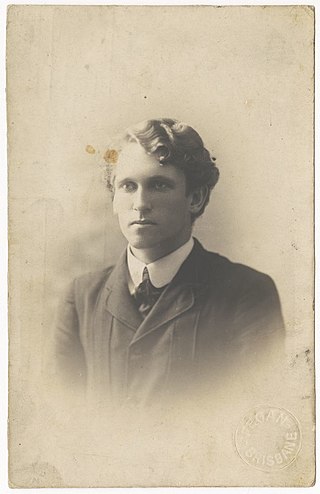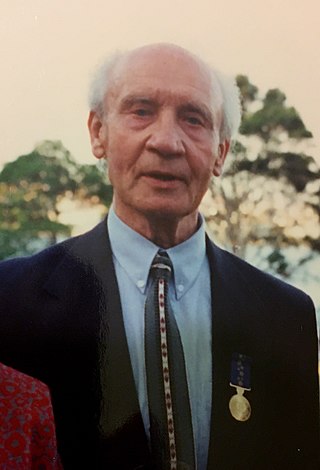
The National Gallery of Australia (NGA), formerly the Australian National Gallery, is the national art museum of Australia as well as one of the largest art museums in Australia, holding more than 166,000 works of art. Located in Canberra in the Australian Capital Territory, it was established in 1967 by the Australian Government as a national public art museum. As of 2022 it is under the directorship of Nick Mitzevich.

William Beckwith McInnes was an Australian portrait painter, winner of the Archibald Prize seven times for his traditional style paintings. He was acting-director at the National Gallery of Victoria and an instructor in its art school.

Margaret Rose Preston was an Australian painter and printmaker who is regarded as one of Australia's leading modernists of the early 20th century. In her quest to foster an Australian "national art", she was also one of the first non-Indigenous Australian artists to use Aboriginal motifs in her work. Her works are distinctively signed MP.

Frank Jeffrey Edson Smart was an expatriate Australian painter known for his precisionist depictions of urban landscapes that are "full of private jokes and playful allusions".

Sir William Dobell was an Australian portrait and landscape artist of the 20th century. Dobell won the Archibald Prize, Australia's premier award for portrait artists on three occasions. The Dobell Prize is named in his honour.
James Timothy Gleeson was an Australian artist. He served on the board of the National Gallery of Australia.

Sir George Russell Drysdale, also known as Tass Drysdale, was an Australian artist. He won the prestigious Wynne Prize for Sofala in 1947, and represented Australia at the Venice Biennale in 1954. He was influenced by abstract and surrealist art, and "created a new vision of the Australian scene as revolutionary and influential as that of Tom Roberts".

Lloyd Frederic Rees was an Australian landscape painter who twice won the Wynne Prize for his landscape paintings.

Elioth Lauritz Leganyer Gruner was an Australian artist.
Kathleen Petyarre was an Australian Aboriginal artist. Her art refers directly to her country and her Dreamings. Petyarre's paintings have occasionally been compared to the works of American Abstract Expressionists Jackson Pollock and Mark Rothko, and even to those of J. M. W. Turner. She has won several awards and is considered one of the "most collectable artists in Australia". Her works are in great demand at auctions. Petyarre died on 24 November 2018, in Alice Springs, Australia.

Steven Martin Cox is an English Australian artist and writer, known for his homoerotic images; stream of consciousness landscapes and animal/human hybrids. He writes art-related and queer-related articles and reviews for various publications.

Michael Kmit was a Ukrainian painter who spent twenty-five years in Australia. He is notable for introducing a neo-Byzantine style of painting to Australia, and winning a number of major Australian art prizes including the Blake Prize (1952) and the Sulman Prize. In 1969 the Australian artist and art critic James Gleeson described Kmit as "one of the most sumptuous colourists of our time".

Richard Kelly Tipping is an Australian poet and artist best known for his visual poetry, word art, and large-scale public artworks. Examples of his work are held in major collections in Australia and abroad.

Elwyn (Jack) Lynn was an Australian artist, author, art critic and curator.

Udo Sellbach (1927–2006) was a German-Australian visual artist and educator whose work focused primarily around his printmaking practice.
Andrew John Sibley was an English-born Australian artist. Sibley has been the subject of three books and is commonly listed in histories and encyclopedias of Australian art as a significant figurative painter of the mid and late 20th century.
Patricia Larter (1936–1996) was an Australian artist who worked across mail art, video, photography, performance and painting. She was "one of the leading figures in the movement known as 'international mail art'". She is credited with coining the term "femail art" that was taken up by other mail artists around the world.

Reinis Zusters was a Latvian-born Australian artist. Zusters was a prolific painter, working predominantly in oils, painting many large landscapes, including triptychs of the Blue Mountains. Zusters drew much of his inspiration from the Australian countryside, depicting the colour and form of nature as a rich and vibrant panorama.
Mandy Martin was a contemporary Australian painter, printmaker and teacher. She was involved in the development of feminist art in Australia from the mid-1970s and as exhibited widely in Australia and internationally. In recent years she used the art she created as part of the ongoing debate on climate change, an area in which she was "prolifically active". Based in Canberra for many years, she was also a lecturer at the Australian National University (ANU) School of Art from 1978 to 2003. As well as being a visual artist, Martin was an adjunct professor at the Fenner School of Environment and Society at the ANU College of Medicine, Biology and Environment.
Marie Hagerty is an Australian artist, painter, sculptor and teacher.













